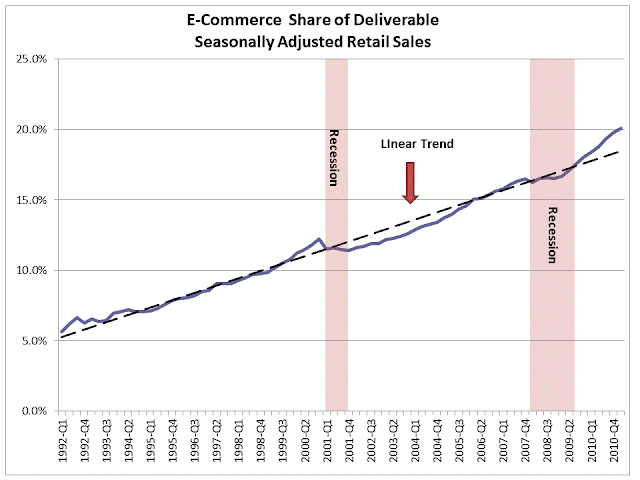E-commerce in the fourth quarter of 2010 for the first time clearly represented more than 20% of all deliverable retail sales. E-commerce's share of retail sales grew by a third in less than 5 years.
The following graph illustrates the change in share of seasonally adjusted retail sales.
The 20% figure represents the proportion of catalog and on-line sales estimated by the Census Bureau as a portion of sales at furniture & home furnishings (442), electronics & appliances (443), clothing & accessories (448), sporting goods, hobby, book, and music (451), general merchandise (452), office supply, stationery, and gift stores (4532) stores as well as on-line and catalog merchants (4541). [The numbers in parentheses are the NAICS codes used by the Census Bureau to classify businesses.] As many retailers, (i.e., Walmart, JCPenney, Target, Best Buy, Limited Brands (Victoria's Secret, Bath and Body Works) and Best Buy) that currently generate most of their sales from brick and mortar outlets now generate a growing proportion of their total sales from their websites, this proportion represents a conservative estimate of the share of deliverable retail sales that FedEx, United Parcel Service or the United States Postal Service are delivering.
The chart above also illustrates, that for most of the period since 1992, delivered retail sales grew as a share of deliverable retail sales has grown by around 50% about every 7 years ( i.e. 6.67% to 10%, 10% to 15%). Since 2005 the rate of growth in delivered market share has quickened and the fifty percent growth rate to a 22.5% market share should come sometime near the end of next year.
The shift of retail from brick-and-mortar to catalog and e-commerce sales will have a profound impact on the retail supply chain, local economies and demand for print communications.
The retail supply chain over the next decade will have little choice but focus on home delivery. Lower-cost deliveries by parcel carriers and other firms to retail outlets will decline while higher-cost deliveries to homes will increase. The need for pick-up locations for high value items will grow which will increase the market for delivery lockers like those used by Deutsche Post, Post Danmark and DHL.
The growth of e-commerce sales will also increase both shorter-haul deliveries from warehouses within carrier one-day, and to a lesser extent two-day delivery windows. The growth of short haul traffic will also allow regional carriers to continue to grow their market share in more densely populated regional markets.
Finally e-commerce sales provide opportunities for integrated carriers like FedEx and UPS. These carriers can manage home deliveryof high-demand, and high-value items that companies like Apple Computer ship direct from warehouses near the manufacturers in China and other countries in the Pacific Rim.
The impact of delivered retail sales on many local economics is significantly negative. Many communities have a retail infrastructure that reflects a world where less than ten percent of all sales were delivered. Shopping malls and strip centers with vacant store fronts will find it more difficult to rent vacant space and will look to non-traditional and more than likely lower paying tenants like government agencies, libraries, medical and dental offices, and service providers like nail salons. Fewer retail stores mean not just fewer retail jobs but also fewer jobs required to build and maintain retail outlets. Lower brick-and-mortar retail sales will have the effect of lowering gasoline consumption as trips to the store are replaced by trips to the computer. To the extent that restaurant and fast food sales are tied to retail shopping, those sales will slip as well.
The shift of retail sales will have some positive impact on communities located near ideal distribution points that can take advantage of one-day delivery standards of ground parcel delivery. These communities should see growth in jobs in warehousing and transportation and may see some growth in other industries that will piggy-back on strengthened transportation infrastructure that e-commerce distribution supports.
Finally, the shift to on-line sales could have a devastating impact on print advertising, and in particular newspaper display ads and direct mail from local merchants. To the extent that on-line sales cause brick and mortar retailers to go bankrupt, the trend removes print advertisers from the marketplace. Remaining retailers may not be willing to pay as much for advertising as the firms they replace. Adding to the challenge facing print advertising is that the largest on-line retailer, Amazon.com, spends minimally on print advertising and its smaller on-line competitors are no different. Printers and the Postal Service need to find a way to create products that fit the needs of on-line retailers who have found that they could grow their business successfully with minimal print advertising if advertising mail and other forms of print advertising can continue to grow.
Sunday, April 24, 2011
Subscribe to:
Post Comments (Atom)





No comments:
Post a Comment